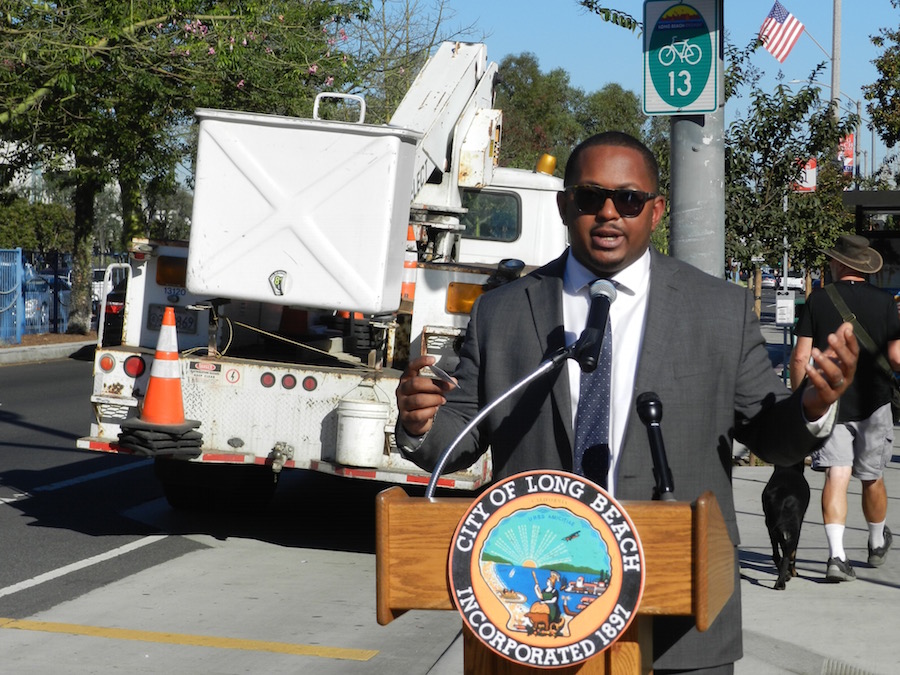
Vice Mayor Rex Richardson holding an UpLink card with instructions on how to access the Atlantic Corridor’s new free wifi network. Photo: Jason Ruiz
Residents and visitors along the Atlantic Corridor in North Long Beach will now have more security and 24-hour free access to the internet, after the city unveiled a project that tied both components together in a ceremony outside Jordan High School Thursday morning.
Vice Mayor Rex Richardson, who represents the district, and several other city officials attended the event, which revealed not only a series of new traffic cameras installed on Atlantic Avenue, but also the corresponding wifi network that will connect them to the city’s police department.
The latter will also provide free wifi access on Atlantic stretching from Jordan High School to the recently opened Michelle Obama Library several blocks to the south.
Richardson ascended to the top of a traffic light post and pulled the coverings off the digital traffic cameras, ones that he said will serve as a deterrent to crime but also provide other valuable information like traffic patterns which can help synch signals more efficiently.
The project grew out of his district’s participatory budgeting initiative last year where the community helped decide what to do with an allocation of about $100,000. The wifi element required an additional $30,000, but the impacts—both economically and socioeconomically—could quickly pay dividends.
“This project has become much more than just a security camera project,” Richardson said. “By installing this infrastructure, every intersection now between Jordan High School and Michelle Obama Neighborhood Library has been equipped to offer free wifi access bridging our school to the library.”
UpLink and it’s “fiber optic backbone” consists of five new access points, which are projected to be able to accommodate up to 200 simultaneous users, with a shared bandwidth of 100 megabytes per second.
The “techquity” element—equitable access to technology like fiber optic internet on Atlantic—was not lost on Long Beach Unified School District (LBUSD) Board Member Megan Kerr, who said this could be a game changer, not just in terms of providing access to a part of the city home to people who may have previously lacked it, but also in starting a much broader conversation.
 “It’s a start. It’s a way to start the conversation around techquity, which is a great word, for our communities,” Kerr said. “Lots of people have mobile devices and that’s their only access, but this potentially, if someone is hanging out at a barbershop or hanging out with their friends, gives them access in a different way.”
“It’s a start. It’s a way to start the conversation around techquity, which is a great word, for our communities,” Kerr said. “Lots of people have mobile devices and that’s their only access, but this potentially, if someone is hanging out at a barbershop or hanging out with their friends, gives them access in a different way.”
How much UpLink will be used for school work is not known but Kerr said that regardless it will have value. The network will provide 60-minute chunks of access to anyone within the radius of the access points now dotting Atlantic and in those 60 minutes they can access information, be it for school or for personal consumption, and Kerr said that’s important.
“Today, especially, I want kids engaged and informed,” she said. “So if they’re not writing their paper but they’re reading the news and seeing what’s happening in their community, that’s important right now. And that’s the way that we change things so hopefully we’ll have a new momentum around being informed.”
UpLink was a precursor to a more recent effort at the city council level to codify a “Dig Once” practice, where fiber optic lines are laid down when street repairs are underway, in an effort to save money, but also expand the city’s internet capabilities.
While the city has expressed an interest in using the Dig Once policy as an economic driver to draw in tech businesses to the city discussions of whether it would become an actual utility provider have not been broached. The idea that access to high speed internet and cities should be legally allowed to provide it has been recognized by the Federal Communications Commission (FCC), and an effort to free up municipalities to provide it is currently tied up in congress.
The lines on Atlantic were laid nearly two years ago, as were separate fiber lines on Artesia Boulevard prior to the city opening bike lanes there earlier this year.
Richardson said that would be the next obvious expansion of UpLink, because of the fact that the lines are already in the ground, but he said if the funding were there, he’d like to do this sort of network building around every high school and middle school.
The benefits of UpLink though may extend past the educational setting. He pointed out that several business plazas set to be developed could now benefit from these wifi access spots, by becoming congregating places for people in the community. The security provided by the cameras and a potential increase in foot traffic could also serve as crime deterrents. The project, he said, has the potential to satisfy a multitude of interests in the community as well as help it grow economically, furthering his Uptown Renaissance efforts.
“A community is not a just a monolithic thing with one interest,” Richardson said. “Sometimes you have to marry the interests of businesses and the property owners with the interests of the youth and the residents. The residents want an activated corridor; this goes a long way to creating an activated corridor.”

